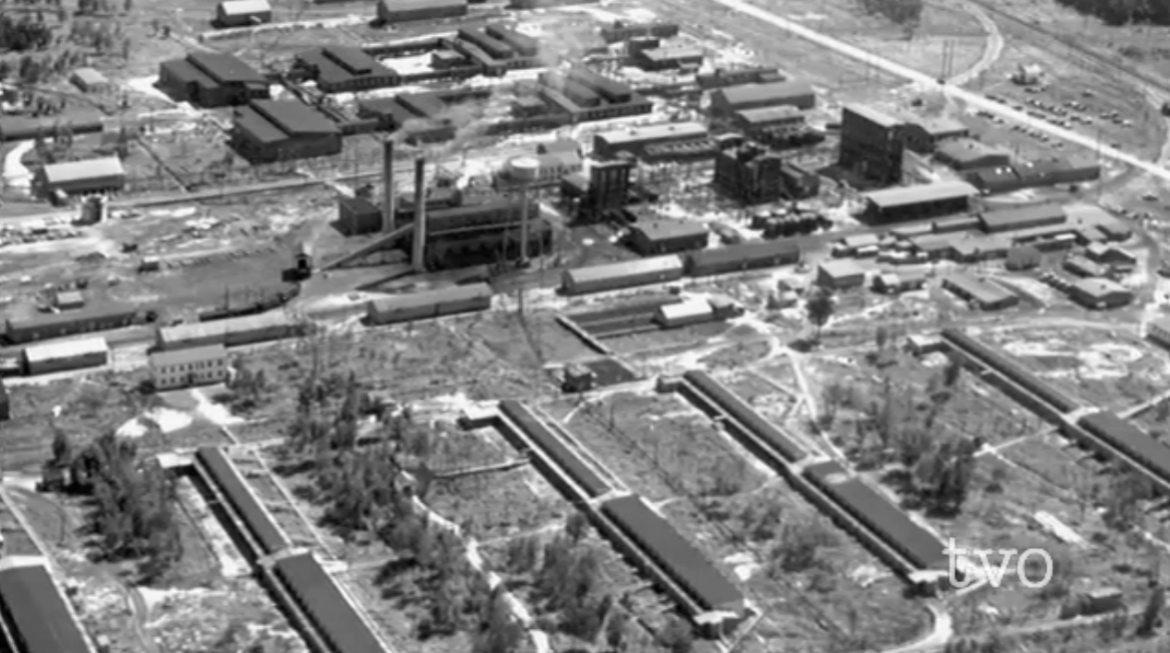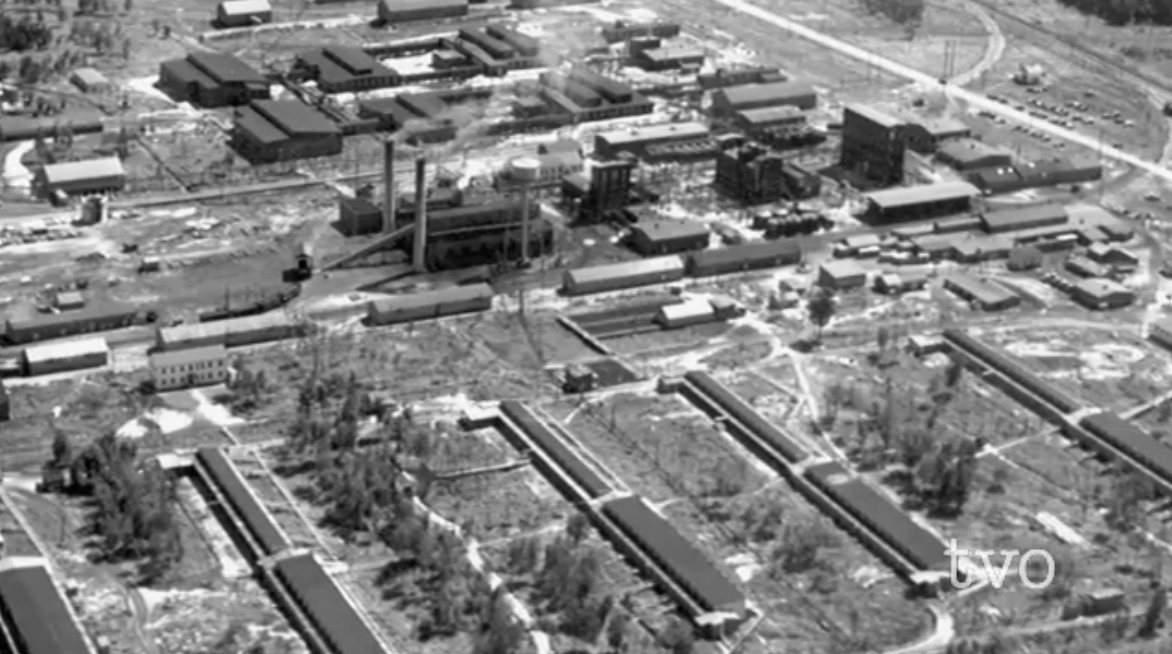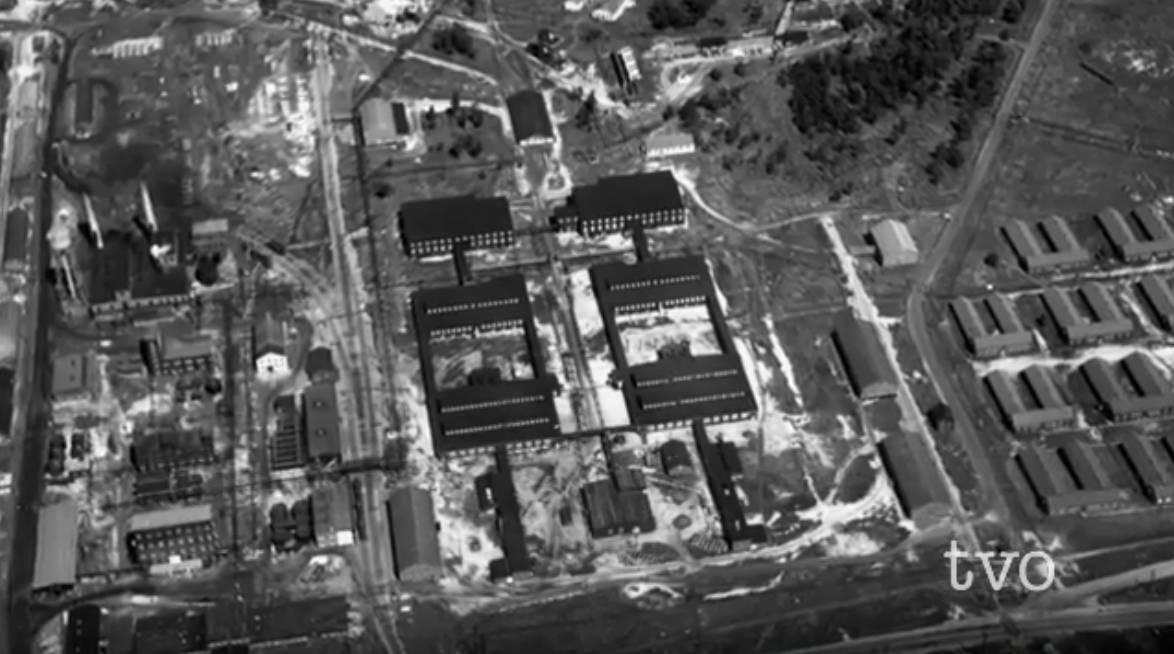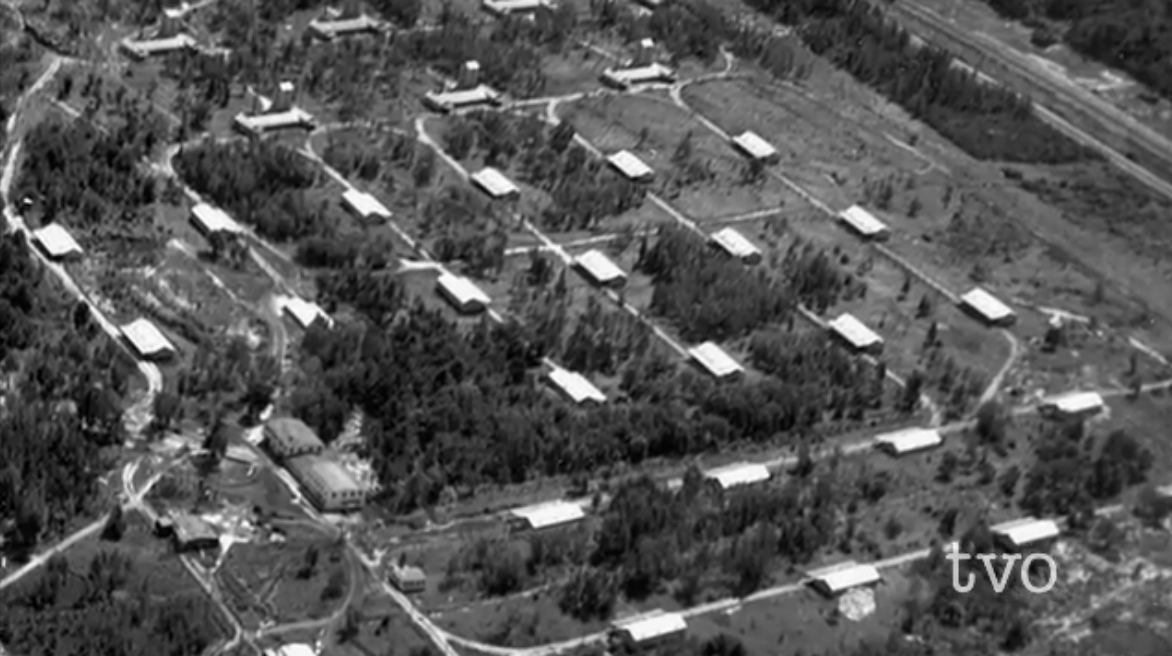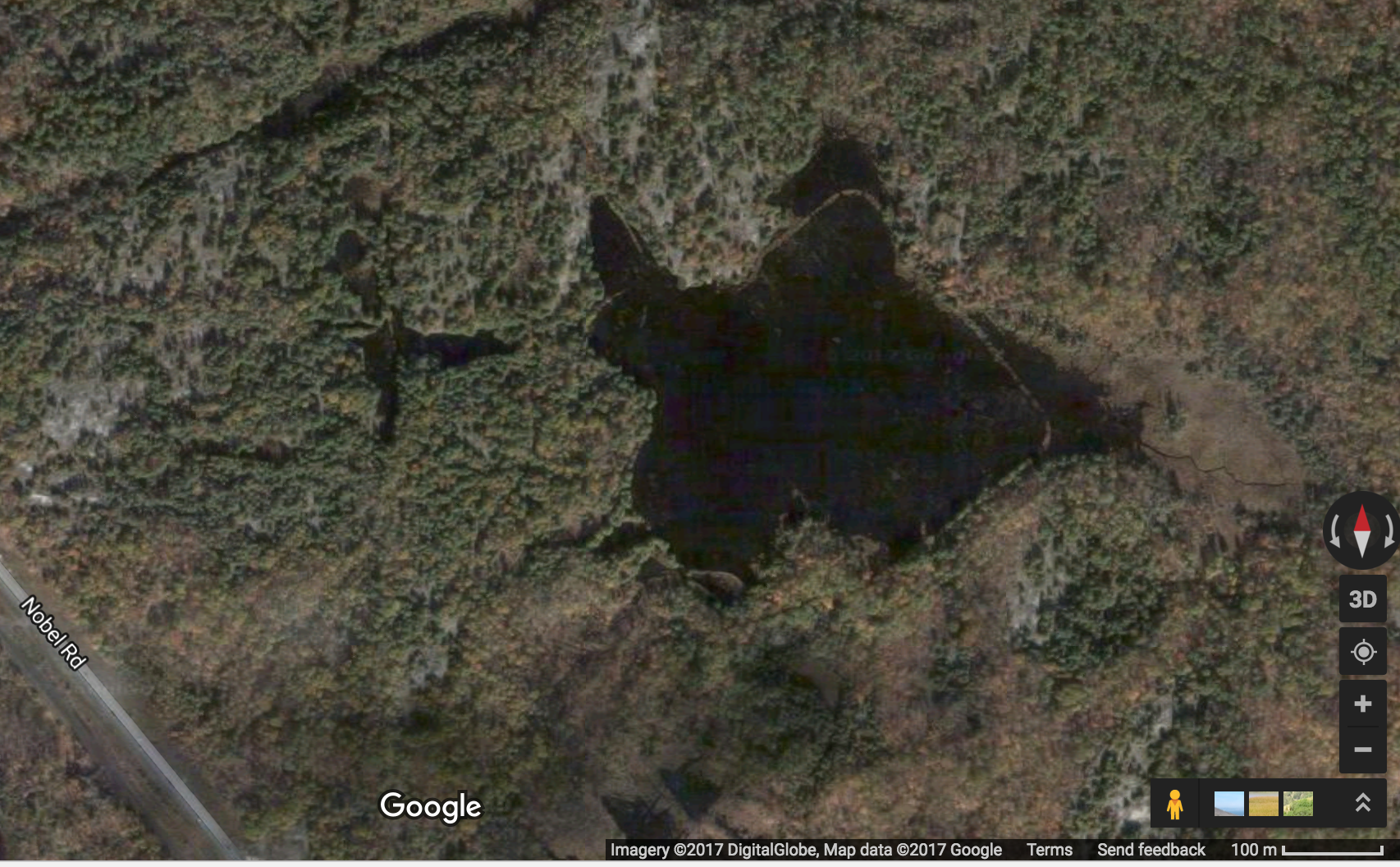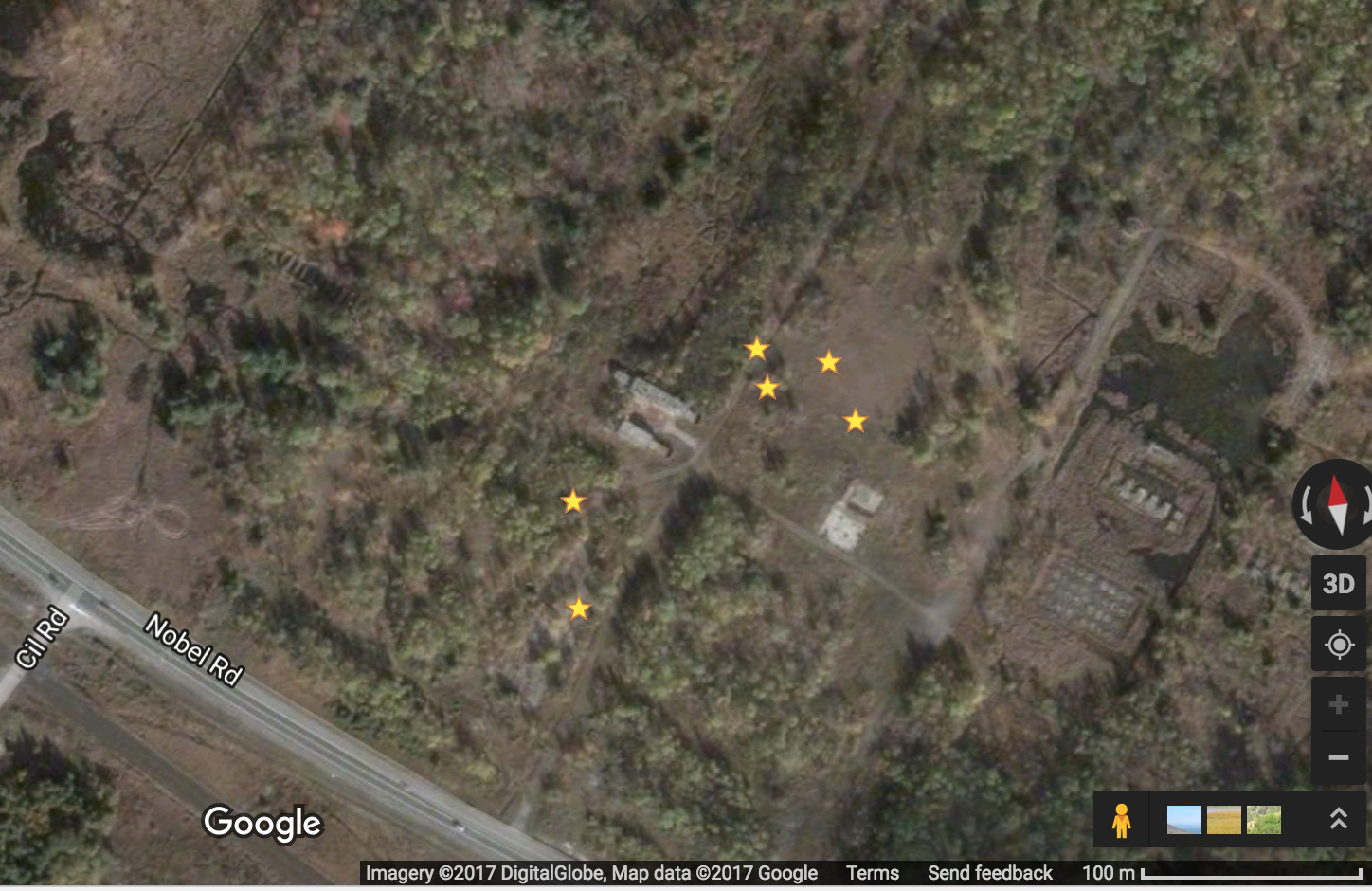Subsections:
Canadian Explosives Limited + Canadian Industries Limited
Guncotton Creek + Guncotton Bay
Deformed or Diseased Local Animals
British Cordite Limited
Defence Industries Limited + Avro Arrow
Purple Fish in Simmes Lake
Grenades in Georgian Bay
CANADIAN EXPLOSIVES LIMITED + CANADIAN INDUSTRIES LIMITED
Nobel, just 9-10km outside of Parry Sound in the McDougall Township and on the shores of Georgian Bay, was home to one of Canada’s largest industrial ammunition and explosive production plants for WWI, WWII and mining operations across North America.
Operations and munitions manufacturing was carried out off and on over the course of 73 years (1912-1985). The quantities and types of products changed over the years.
At the request of Canadian Explosives Limited (CXL), the small farming and logging town of Ambo was renamed after Alfred Nobel, the inventor of dynamite.
Images above: Overview of CIL facilities (first), double guncotton line (second), drying stoves (third).
In 1912, the treasurer of CXL, Mr. Frank Lankford and his associates from Grubb & Staples1, secured over 5,100 acres for CXL; spanning both sides of the train tracks, which is known now as the old Highway 69.
It was only after the land was purchased that local residents were informed that the property was not going to be used for a ranch or goat farm, as they were led to believe, but for producing dynamite and blasting gelatin for mining operations across Canada2.
The site was well-chosen for an explosives plant. It was surrounded by marsh lands. There was access to fresh water from Simmes Lake and Georgian Bay. The rail line from Sudbury to Toronto went straight through the property and Parry Sound was close enough for access to labour, but far enough away to mitigate the risk from an explosion.
In 1914, the plants were completed. War broke out in Europe and CXL began manufacturing military explosives. In December that year, in addition to dynamite and gelatin, CXL produced size 8 cordite. Cordite is a smokeless propellant used to replace gun powder. It is a mix of guncotton and nitroglycerine.
Cordite production began in 1915 and soon-after doubled in size to 40,000lbs/day. By 1918, they were producing 1,500,000lbs/month.
GUNCOTTON CREEK + GUNCOTTON BAY
A guncotton plant was built on the site around the same time and began manufacturing in August, 1915. The guncotton plant used a local swamp just south east of its location to dispose of the plants large volumes of guncotton process water. This method of disposing waste was carried out consistently until December 19183.
Reg. Honley writes in a document found at the Museum on Tower Hill dated March 1986:
Apparently, the water carried with it considerable guncotton, a good deal more perhaps than modern standards would tolerate. In any event, over the years of the swamp, barren and free of vegetation, acted as a catch basin or sump for the water-borne guncotton. The fact that this out-of-the-way area might become a tinder box was overlooked, or forgotten, or underestimated.
A normal summer with occasional rain was no great risk but one summer about 1922 was hot and dry. Late in August a park from a passing CPR steam locomotive ignited the dry guncotton. The result was a sudden and extremely fierce fire with flame and smoke visible for miles. It proved very difficult to extinguish and the CPR fought it with about two hundred men and a tank car train of water that shuttled between the fire and Parry Sound. Even then it burned for three or four days and was not finally put out until the swamp was completely drowned.
Twice more in the plant shutdown period of 1922-1926 the area blazed up again. Each successive fire was less severe and burned itself out. By the late 20s fresh vegetation had appeared, this growth continued, and today there is no evidence of the original firepot.
Meanwhile, the small watercourse that drained the area and ended in the Bay became known locally as Guncotton Creek and the shoreline as Guncotton Bay. Some guncotton and any that might have settled on the banks of the little stream had been carried down to Guncotton Bay by the high runoff every spring. The result was considerable amount of guncotton on the Bay shore near the stream mouth. These shoreline deposits were finally cleaned up and disposed of in the 1960s, some 40 years after the guncotton had been made in World War 14.
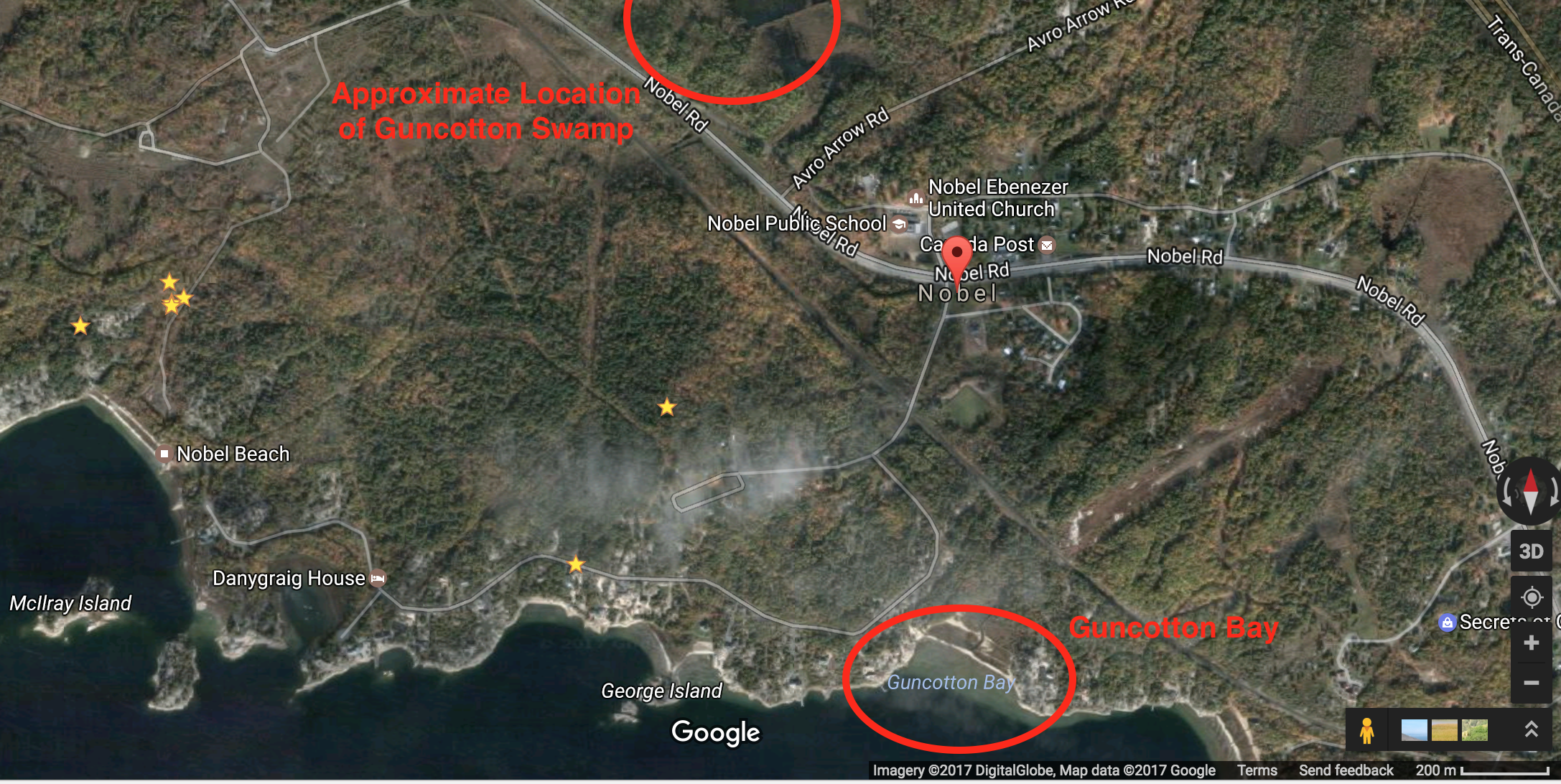
Image (above): Google Satellite image of Nobel; showing the distance between Guncotton swamp and Guncotton Bay as well as its proximity to residents homes and the Nobel elementary school. *Yellow stars indicated locations of some monitoring wells.
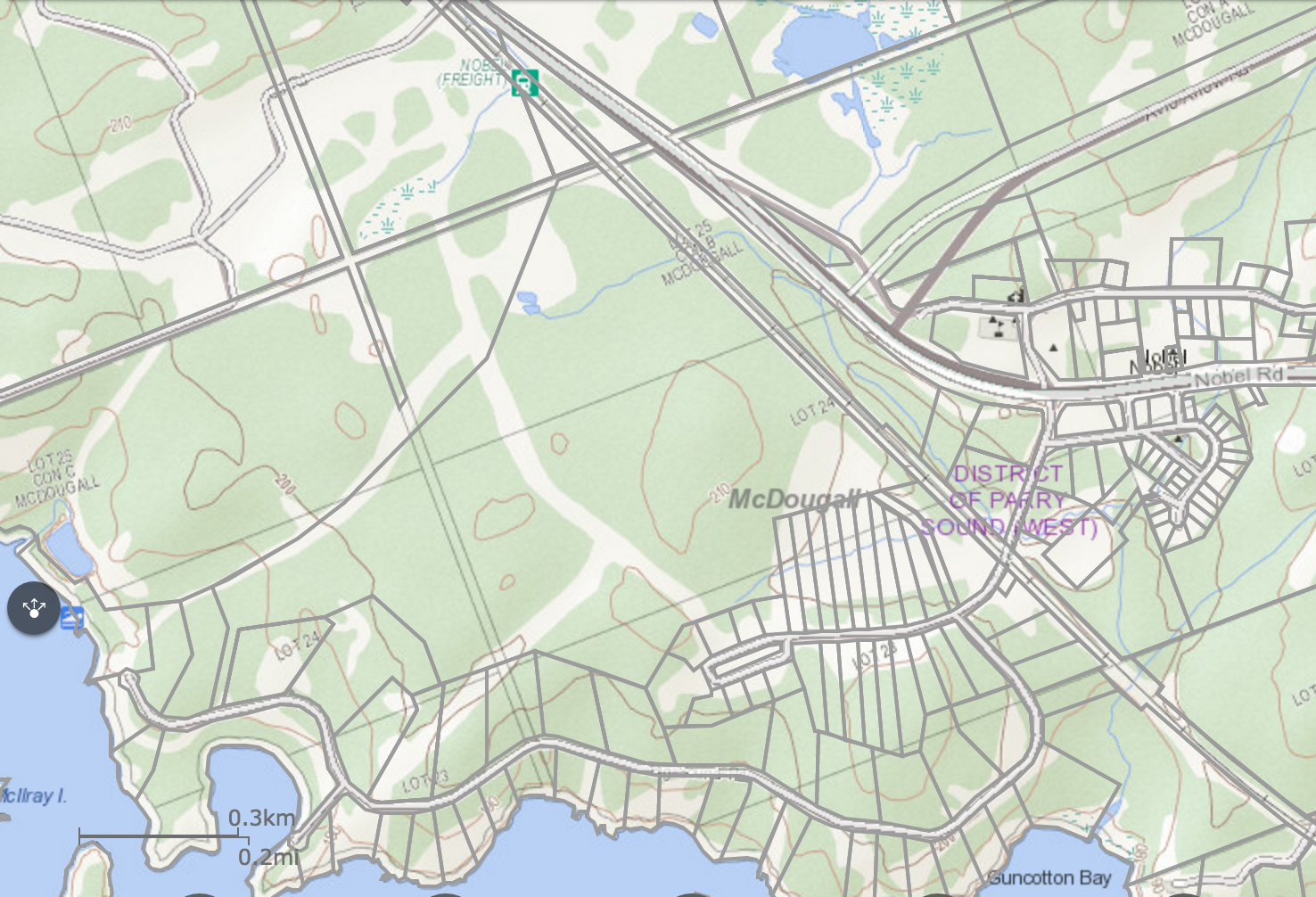
Image (above): West Parry Sound Geography Network (WPSGN) ARCGIS map of Nobel; showing the swamp runoff or Guncotton Creek into Guncotton Bay (Georgian Bay).
According to lay knowledge, Guncotton Creek originated on the north side of Nobel Road on the British Cordite Limited (BCL) property (later known as the Defence Industries Limited (DIL) property) near Avro Arrow Road and the westside of Nobel Elementary School. It crossed Nobel Road (the old Highway 69), passed through Nobel Village (as it is today) and came out on the east side of Big Sound Road, which is where Guncotton Creek ends and Guncotton Bay (Georgian Bay) begins.
The swamp where guncotton process water was dumped is approximately:
- 1.2km from Nobel Village
- 1km from Nobel Elementary School
- 1.5km from Nobel Beach (Georgian Bay)
- 2km from Guncotton Bay (Georgian Bay)
- 10km from the town of Parry Sound
DEFORMED OR DISEASED LOCAL ANIMALS
A local resident shared a story about their dog swimming in the old swamp in the late 90s-early 00s. A few days afterward the dog came down with a deadly skin disease, which nearly killed it. The family always wondered if the disease occurred as a result of the pet swimming in the old swamp.
The old CIL and BCL properties are currently abandoned and have become hiking, snowmobiling and four-wheeling trails and hunting grounds for local residents.
There are hunting stories of deformed deer from the 90’s in Carling Township, the neighbouring township to McDougall (Nobel).
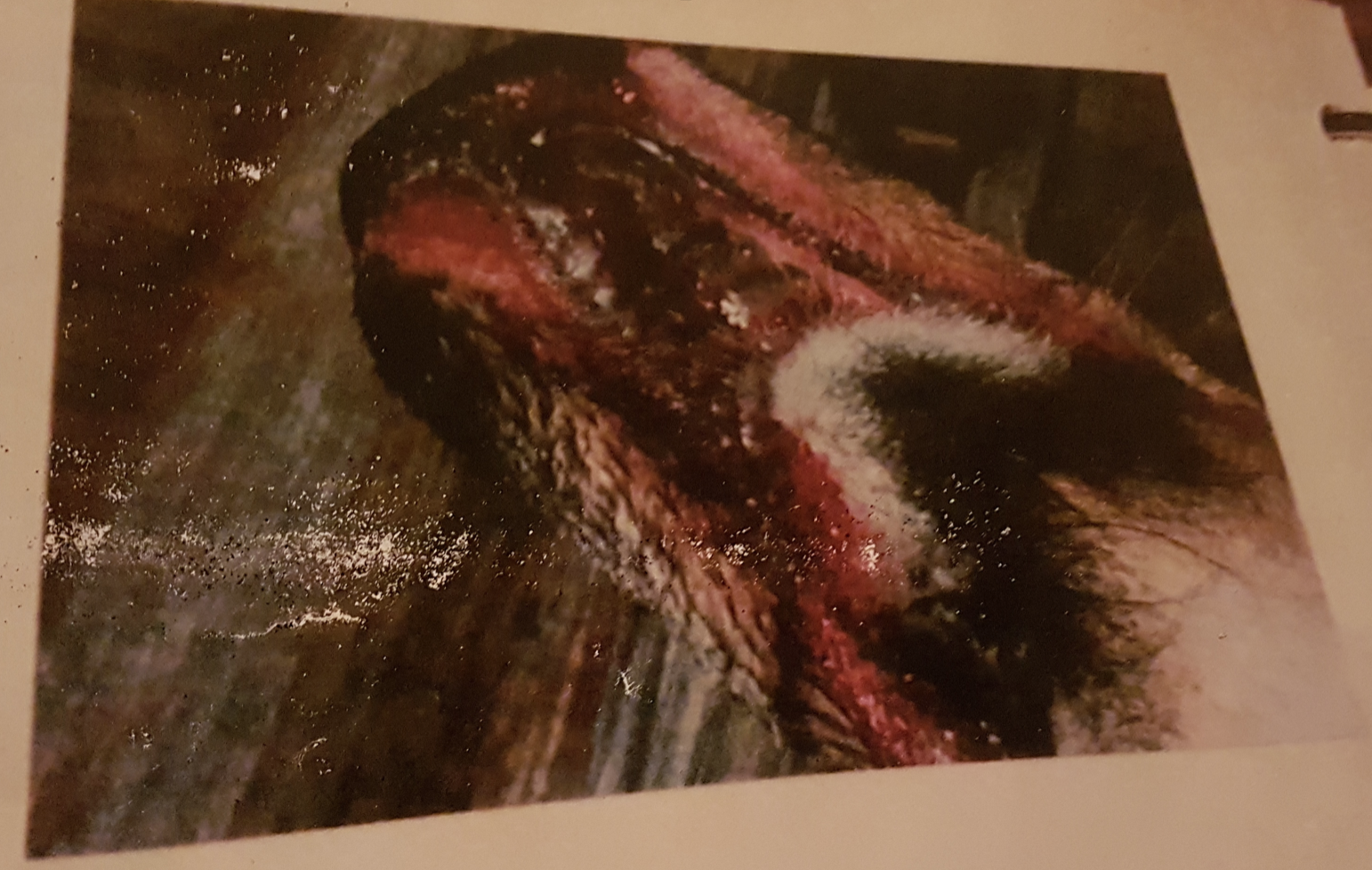
Image (above): photo of a deer with an underdeveloped jaw – hunted in Carling Township in the 90s. This was not considered “uncommon” but was recalled as the worst case.
The dumping of the guncotton process water caused mass environmental contamination on the shores of Georgian Bay, which was why Nobel Village moved inland to where it is located now5.
BRITISH CORDITE LIMITED
In December 1915, the Imperial Munitions Board built a cordite plant called British Cordite Limited (BCL) because of the demand for size 8 cordite. BCL was operated by CXL employees. This site covered 366 acres and had 155 buildings6.
In August 1917, the plant was manufacturing 80,000lbs/day, using the same local swamp as CXL to dispose of guncotton process water. By 1918, it had produced 21,450,000lbs of cordite7. Additional plants were built, including ones for TNT and shrapnel-loading. The shrapnel-loading plant was closed quickly after an explosion which killed 7 people8.
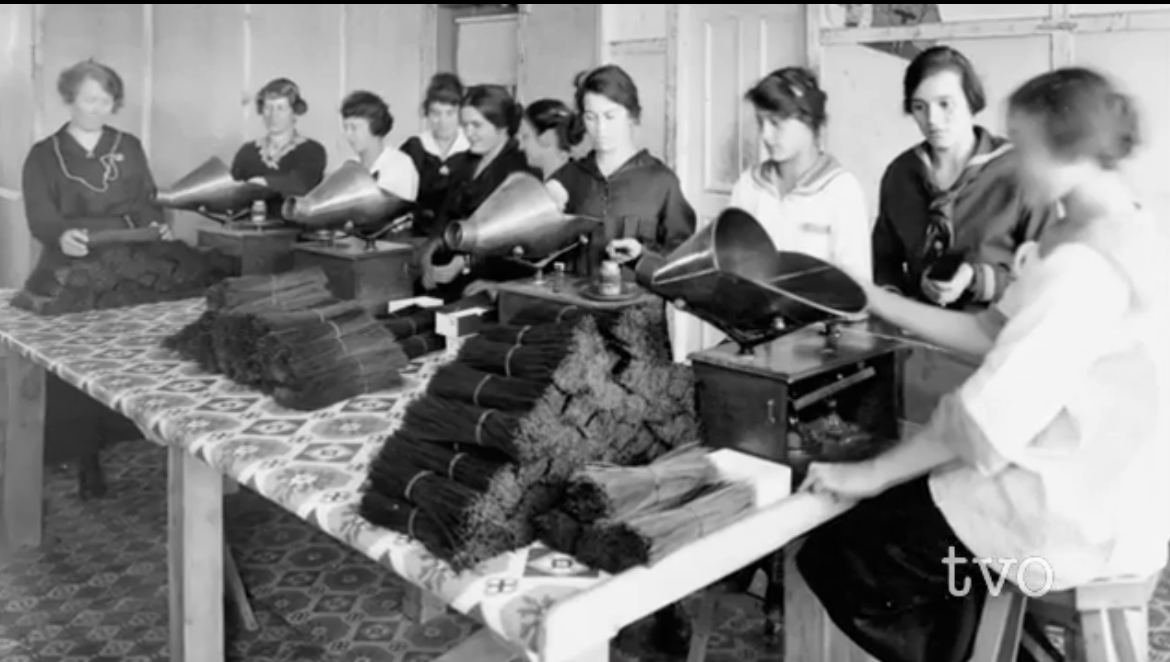
Image (above): women working with cordite at the factories.
After WWI, the cordite and gun-cotton plants were closed. CXL concentrated on dynamite and gelatin for mining across the continent. In 1922, the remaining plants were closed.
In 1927, CXL changed its name to Canadian Industries Limited (CIL) because they began making paints and varnishes.
DEFENCE INDUSTRIES LIMITED + AVRO ARROW
Defence Industries Limited (DIL) was a crown corporation formed to handle the construction, operation and management of Crown-owned munitions plants.
In 1939, DIL constructed additional manufacturing facilities on the old BCL property. At the outbreak of WWII, CIL put its technological experience at the service of the Canadian government — CIL managers ran DIL’s operations. Therefore, DIL was federally owned, but privately operated.
This working relationship between CIL and the federal government existed prior to WWII, as they also asked CXL to supervise the construction of the BCL cordite plant prior to its production in 19179.
DIL erected buildings for the production of nitroglycerine, TNT, guncotton, cordite, nitric and sulfuric acid and employed about 4300 people. In contrast, the population of the town of Parry Sound in 2011 was 6,19110.
According to lay knowledge, DIL’s employee population was larger than the town of Parry Sound and was a larger operation than BCL, which was once producing more than 80,000lbs of cordite/day.
At the end of WWII, DIL’s buildings containing explosives were destroyed and taken over by War Assets Disposal Corporation (now called Crown Assets Distribution Service Line, part of Public Works Dept. of the Government of Canada). Meanwhile, CIL continued the production of dynamite and blasting gelatin on its original site.
In 1946, the Avro Arrow moved onto the old DIL property to test the Orenda Engine. This continued until 1959 when the Avro Arrow was shut down by Prime Minister Diefenbaker.
Different laws and regulations apply to public and private companies regarding the sharing of information. Because of the involvement of the federal government on this property, can you access information regarding the environment or the closure of buildings through FIPPA (freedom of information request) or the Crown Assets Distribution Service Line?
PURPLE FISH IN SIMMES LAKE
There is a lot of local lay knowledge regarding the dumping of munitions and other industrial waste into Simmes Lake, which runs directly into Georgian Bay. Baby Boomers’ parents warned their children never to swim or fish in Simmes Lake for that reason. Locals also recall their parents and grandparents telling them that there were purple fish in the lake, which was attributed to the high levels of contamination.
In addition, when you view the nearby ponds and marshes of Simmes Lake on Google Satellite images, you will see a pond that appears to have once had a retaining wall of some kind. Was this another location for industrial dumping at some time between 1912 & 1985 when there was munitions production?
First image: Possible retaining wall in pond on DIL property (north-side of Nobel Road).
Second image: Red circle outlining possible trenches dug for industrial waste.
What type of lining was used for the retaining wall? What types of industrial waste was dumped there? Has the seal broken? If so, how extensive has the migrating contamination been? Are there MOE documents regarding this pond or marsh? Has the environmental contamination been remediated or contained? Has anyone tested for migrating contamination (e.g. CIL, the MOE and Climate Change, the municipality, provincial or federal government)? Keep in mind how different environmental laws, regulations and standards were in the 1900s compared to now.
Sources have said that CIL buried hazardous industrial waste, including tanks containing chemicals, into rows of trenches. Do the rows of lines found on Google Satellite images show where these trenches are located? What else can Google Satellite images reveal?
Refer to the section, TriMac: CIL’s transportation company, for more information.
GRENADES IN GEORGIAN BAY
It has also been said that in the spring CIL used to take loads of industrial waste onto the Georgian Bay ice. When the ice melted it would be ‘out of sight, out of mind’ — such was the wartime mentality. This practice was not uncommon for TNT and dynamite production waste during wartime in North America.
So, while no recorded documentation confirms this happened in Nobel, one local resident has evidence of another kind: a 5-10lb artillery shell that washed up onto the shoreline.
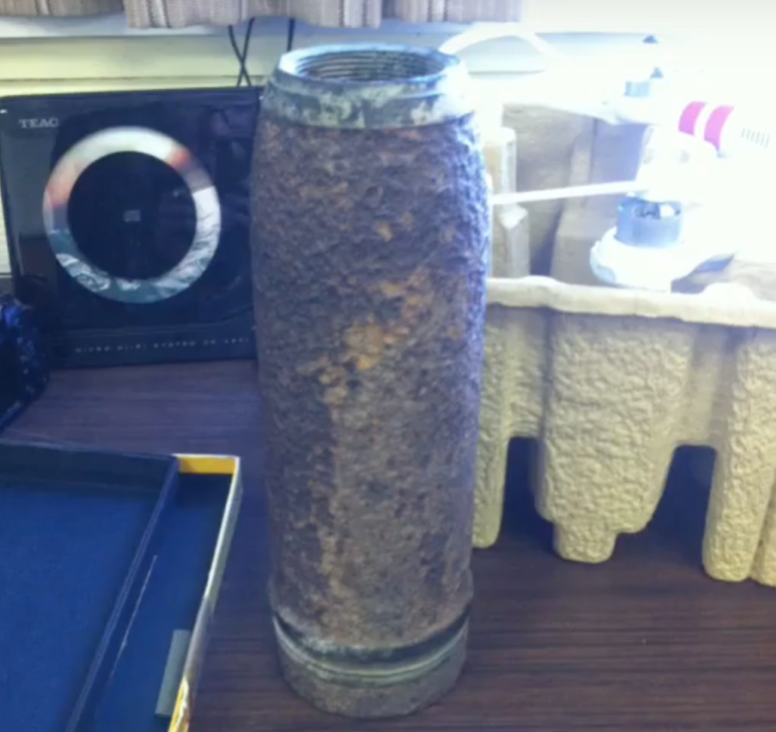
Image (left): artillery shell that washed up onto the shoreline of Georgian Bay
There are also stories of grenades washing up on Georgian Bay beaches in the 90’s and into the hands of children.
Refer to the section, The Department of Defence in Parry Sound, for more information.
- Peter McVey, “An Overview of the Village of Nobel,” File 4164, Museum on Tower Hill, February, 4 1985.
- Peter McVey, “An Overview of the Village of Nobel,” File 4164, Museum on Tower Hill, February, 4 1985.
- “Boomtown: Explosives Manufacturing in Nobel, Ontario during the Second World War,” Essay, Museum on Tower Hill, date unknown, Page 5.
- Reg. Honley, “A Short History of Nobel Works,” File ALE 296J-2, Museum on Tower Hill, March, 1986.
- “Rooted in Stone Reflections on West Parry Sound’s Past,” DVD, Ontario Visual Heritage Project, 2009.
- Carnegie, David. The History of Munitions Supply in Canada 1914-1918. New York: Longmans, Green and Co., 1925. Accessed on Wikipedia, May 10, 2017, https://en.wikipedia.org/wiki/Nobel,_Ontario.
- Carnegie, David. The History of Munitions Supply in Canada 1914-1918. New York: Longmans, Green and Co., 1925. Accessed on Wikipedia, May 10, 2017, https://en.wikipedia.org/wiki/Nobel,_Ontario.
- “History of Nobel.” Parry Sound Library, Accessed May 10, 2017, https://www.parrysoundlibrary.com/nobel-history.
- “Boomtown: Explosives Manufacturing in Nobel, Ontario during the Second World War,” Essay, Museum on Tower Hill, date unknown, page 4.
- StatsCan.
